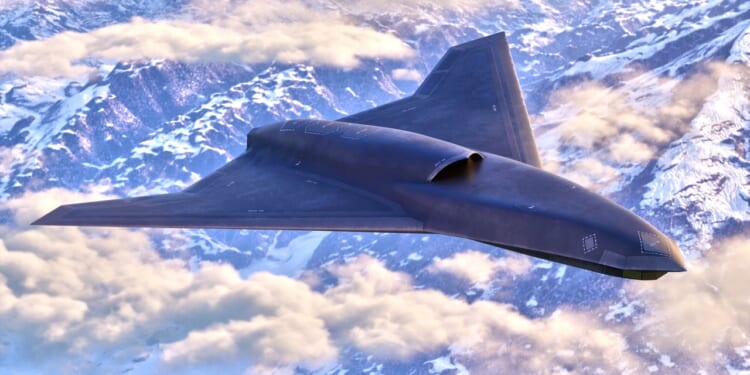As the cost of sixth-generation planes skyrockets, unmanned “loyal wingman” drones like the Vectis will become essential to help them accomplish their missions.
The global arms race for unmanned combat systems is in full swing. The Ukraine War has shown the future of warfare to the world. Just as the tank revolutionized warfare during the early 20th century, the drone will revolutionize it during the 21st.
Enter Lockheed Martin and its new, cutting-edge Vectis uncrewed collaborative combat aircraft (CCA) developed by the company’s legendary (yet paradoxically highly secretive) Skunkworks division. Unveiled on September 21, this drone emphasizes survivability, lethality, and stealth that is both very capable while being remarkably affordable.
Positioned as a stealthy drone wingman, Vectis prioritizes low observability to operate in contested environments—drawing on decades of Skunk Works expertise in fighter aircraft, autonomous systems, and open mission architectures.
Why Does the Vectis Drone Matter?
Lockheed plans for their Vectis CCA to support a broad range of operations, including air-to-air combat, air-to-ground precision strikes, intelligence, surveillance, and reconnaissance (ISR) targeting, electronic warfare, and both offensive and defensive counter-air tasks. This system offers multi-domain connectivity and can function independently or in teaming scenarios, notably with crewed platforms like the F-35.
All this is a test run for what will inevitably be a pairing of the United States Air Force’s upcoming F-47 sixth-generation warplane—now said to be on track for its first flight in 2028—with CCA like the Vectis.
Built with advanced stealth technologies, the Vectis will provide best-in-class survivability in its category, leveraging speed, altitude, shape, and materials to thrive in high-threat areas. As for its range, the CCA is designed for extended operations that are compatible with all the primary theaters in which US forces operate.
What’s more, the Vectis is designed with an open systems design, making it easy to integrate with all manner of manned aircraft. This enhances the CCA’s effectiveness, as well as its interoperability.
Another major selling point in favor of the Vectis drone is its affordability. Lockheed employed digital engineering when making the Vectis—and also integrated hard lessons learned from the construction of the next-generation manned warplanes it was also working on. By incorporating these lessons, Lockheed ensured that its Vectis would be competitive on the world market—as well as lethal on the modern battlefield.
Drones Will Keep Lockheed Martin Relevant for Years
Development is underway, with parts for the Vectis already ordered and a dedicated design team in place. Lockheed Martin is investing internal resources to build and test the Vectis, aiming for the first test flight by 2027—within two years of the announcement. The first prototype is currently in progress.
Lockheed Martin has struggled in recent months, losing a string of high-profile contracts—notably failing to secure the main contract to build the “F-47” Next Generation Air Dominance (NGAD) sixth-gen fighter, losing out to rival aerospace firm Boeing. However, as the market shifts increasingly from manned to unmanned platforms, by cornering the market first with systems like the Vectis, Lockheed is set to make itself a long-term feature in the defense industry.
The rise of CCAs and drones more generally are giving Lockheed a real competitive place in the defense sector. Sure, Boeing will have its sixth-generation warplane windfall. Eventually, however, the Pentagon will recognize the folly of relying on manned warplanes in a future characterized by unmanned warfare. What’s more, the cost of the F-47—and possibly the Navy’s F/A-XX fighter as well—will mean that there will never be enough of these planes available for a great power conflict.
That’s where Lockheed Martin’s CCAs, like the Vectis, will come into play. They’ll become essential for these limited manned sixth-generation birds to accomplish their missions, as the CCAs will drastically augment the fighting prowess of the manned sixth-generation warplanes—all while minimizing the risks that enemy air defenses pose to manned US warplanes.
In short, Lockheed Martin is ensuring that its products—not Boeing’s or another major rival’s—will dominate the arms industry of tomorrow.
About the Author: Brandon J. Weichert
Brandon J. Weichert is a senior national security editor at The National Interest. Recently, Weichert became the host of The National Security Hour on America Outloud News and iHeartRadio, where he discusses national security policy every Wednesday at 8pm Eastern. He is also a contributor at Popular Mechanics and has consulted regularly with various government institutions and private organizations on geopolitical issues. Weichert’s writings have appeared in multiple publications, including The Washington Times, National Review, The American Spectator, MSN, The Asia Times, and others. His books include Winning Space: How America Remains a Superpower, Biohacked: China’s Race to Control Life, and The Shadow War: Iran’s Quest for Supremacy. His newest book, A Disaster of Our Own Making: How the West Lost Ukraine is available for purchase wherever books are sold. He can be followed via Twitter @WeTheBrandon.
Image courtesy of Lockheed Martin.
















